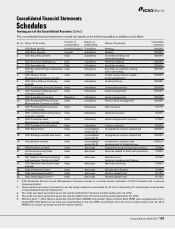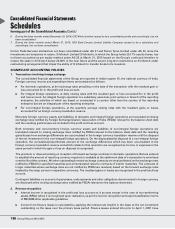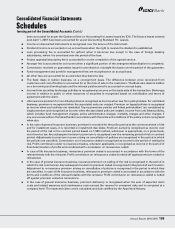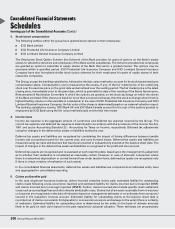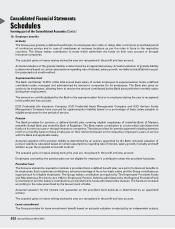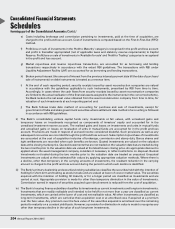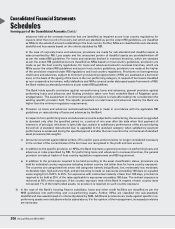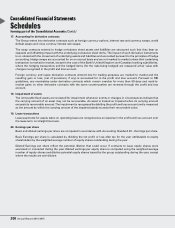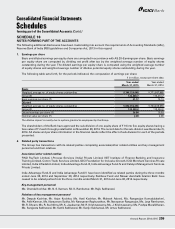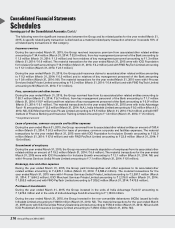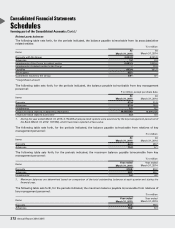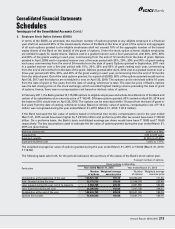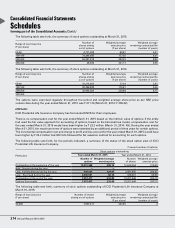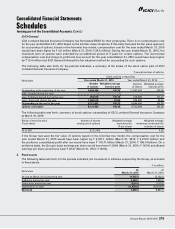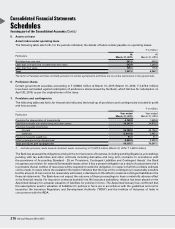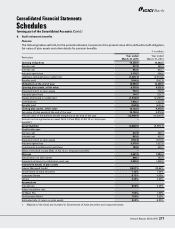ICICI Bank 2015 Annual Report Download - page 209
Download and view the complete annual report
Please find page 209 of the 2015 ICICI Bank annual report below. You can navigate through the pages in the report by either clicking on the pages listed below, or by using the keyword search tool below to find specific information within the annual report.
forming part of the Consolidated Accounts (Contd.)
Schedules
207Annual Report 2014-2015
Consolidated Financial Statements
iii) In the case of the Bank’s overseas banking subsidiaries, loans are stated net of allowance for credit losses. Loans
are classified as impaired and impairment losses are incurred only if there is objective evidence of impairment
as a result of one or more events that occurred after the initial recognition on the loan (a loss event) and that loss
event (or events) has an impact on the estimated future cash flows of the loans that can be reliably estimated. An
allowance for impairment losses is maintained at a level that management considers adequate to absorb identified
credit related losses as well as losses that have occurred but have not yet been identified.
The total proportion of loans for which subsidiaries have applied accounting policies different from the Bank as
mentioned above, is approximately 10.12% of the total loans at March 31, 2015.
15. Transfer and servicing of assets
The Bank transfers commercial and consumer loans through securitisation transactions. The transferred loans are
de-recognised and gains/losses are accounted for only if the Bank surrenders the rights to benefits specified in the
underlying securitised loan contract. Recourse and servicing obligations are accounted for net of provisions.
In accordance with the RBI guidelines for securitisation of standard assets, with effect from February 1, 2006, the
Bank accounts for any loss arising from securitisation immediately at the time of sale and the profit/premium arising
from securitisation is amortised over the life of the securities issued or to be issued by the special purpose vehicle to
which the assets are sold. With effect from May 7, 2012, the RBI guidelines require the profit/premium arising from
securitisation to be amortised over the life of the transaction based on the method prescribed in the guidelines.
In the case of loans sold to an asset reconstruction company, the excess provision is not reversed but is utilised to meet
the shortfall/loss on account of sale of other financial assets to securitisation company (SC)/reconstruction company
(RC) in accordance with RBI guideline dated July 13, 2005. With effect from February 26, 2014, in accordance with
RBI guidelines, in case of non-performing loans sold to SCs/RCs, the Bank reverses the excess provision in profit and
loss account in the year in which amounts are received. Further, the RBI circular dated March 11, 2015 has allowed to
reverse the excess provision/reserve on account of sale of NPAs prior to February 26, 2014 to profit and loss account.
The Canadian subsidiary has entered into securitisation arrangements in respect of its originated and purchased
mortgages. ICICI Bank Canada either retains substantially all the risk and rewards or retains control over these
mortgages, hence these arrangements do not qualify for de-recognition accounting under their local accounting
standards. It continues to recognise the mortgages securitised as “Loans and Advances” and the amounts received
through securitisation are recognised as “Other borrowings”.
16. Fixed assets and depreciation
Premises and other fixed assets are carried at cost less accumulated depreciation and impairment, if any. Cost includes
freight, duties, taxes and incidental expenses related to the acquisition and installation of the asset. Depreciation
is charged over the estimated useful life of a fixed asset on a straight-line basis. The useful life of fixed assets for
domestic group companies is based on past experience and expectation of usage, which for some categories of fixed
assets, is different from the useful life as prescribed in Schedule II of the Companies Act, 2013.
Assets purchased/sold during the period are depreciated on a pro-rata basis for the actual number of days the asset
has been put to use.
In case of the Bank, items costing up to ` 5,000/- are depreciated fully over a period of 12 months from the date of
purchase.
In case of revalued/impaired assets, depreciation is provided over the remaining useful life of the assets with reference
to revised asset values.


